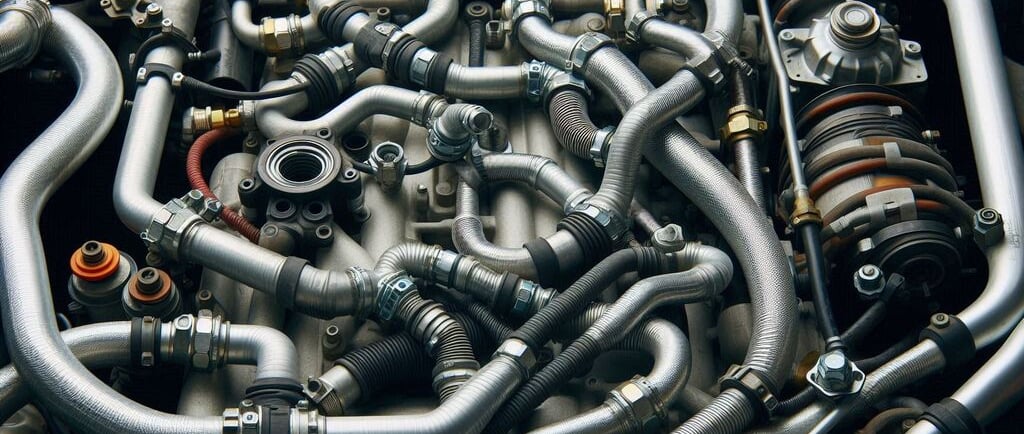Hoses: Connect various components of the cooling system (e.g., radiator hoses, heater hoses).
When it comes to your car's cooling system, it’s not just the radiator or coolant that keeps everything in balance.
COOLING SYSTEMS
11/11/20244 min read


Hoses in Your Cooling System: Connecting and Protecting Your Engine
When it comes to your car's cooling system, it’s not just the radiator or coolant that keeps everything in balance. Essential hoses connect various components, allowing coolant to flow and preventing your engine from overheating. In this article, we’ll explore the types of hoses, their role in cooling, and tips for keeping them in top condition.
What Are Cooling System Hoses and Why Are They Important?
Cooling system hoses, including radiator hoses and heater hoses, connect different parts of your car’s cooling system. They create pathways for the coolant to travel from the radiator to the engine and back, absorbing heat from the engine and releasing it through the radiator.
Key Types of Cooling System Hoses
Radiator Hoses: These larger hoses transfer coolant between the engine and the radiator. Radiator hoses come in two parts – the upper hose, which carries coolant from the engine to the radiator, and the lower hose, which sends it back from the radiator to the engine after cooling.
Heater Hoses: Smaller than radiator hoses, heater hoses circulate coolant to the heater core, which warms the air in your cabin. These hoses are essential for maintaining interior comfort during cold weather.
Each type of hose serves a unique purpose, but all work together to regulate temperature, protect the engine, and keep you comfortable on the road.
How Do Hoses Support Your Engine’s Cooling System?
Your car’s cooling system is like a circulatory system for heat management. Coolant hoses enable efficient movement of the coolant between various parts, ensuring consistent engine temperature.
The Flow of Coolant
Radiator Hoses: When the engine heats up, the thermostat opens, allowing coolant to flow into the upper radiator hose. The coolant absorbs heat from the engine and moves into the radiator, where it cools. Then, it returns to the engine through the lower radiator hose.
Heater Hoses: When the heater is turned on, some of the hot coolant from the engine flows through the heater core. The blower motor blows air over the heater core, warming the air and sending it into the cabin.
Benefits of Cooling System Hoses
Without these hoses, the coolant couldn’t circulate effectively, causing engine overheating and possibly significant damage. Regular inspection and maintenance are key to avoiding these issues.
Signs of Worn or Damaged Hoses
Over time, cooling system hoses can wear out, leak, or even burst. Recognizing early signs of damage can prevent costly repairs.
1. Visible Cracks or Bulges
If you see cracks, bulges, or tears in any hoses, it’s a strong indicator that they’re wearing out. These signs mean the rubber has weakened, likely from age or exposure to high heat, and could fail soon.
2. Coolant Leaks
A visible coolant leak, whether on the driveway or under the hood, is a clear sign that a hose might have a crack or a loose clamp. It’s essential to address leaks promptly to avoid overheating.
3. Engine Overheating
A sudden spike in engine temperature often indicates that the coolant isn’t circulating properly. This can be due to a failing hose, a coolant leak, or other issues in the cooling system.
4. Soft or Brittle Hoses
Press the hoses carefully (when the engine is cool!) – if they feel too soft, squishy, or brittle, it’s likely time for a replacement. Healthy hoses should be firm but flexible.
How to Maintain and Replace Cooling System Hoses
Maintaining your cooling system hoses is relatively simple, and regular inspection can prevent more severe issues down the road. Here are some easy tips:
1. Inspect Hoses Regularly
Make it a habit to check your cooling system hoses every few months or whenever you have an oil change. Look for signs of wear, cracks, leaks, or unusual softness.
2. Keep Hoses Clean and Secure
Dirt and debris can damage hoses, so wipe them down occasionally. Also, check that the clamps securing them are tight – a loose clamp can lead to leaks.
3. Replace Hoses as Needed
Hoses generally last between 4-5 years but can wear faster depending on driving conditions and climate. If you notice any signs of wear or damage, it’s better to replace the hose than risk engine damage.
DIY Hose Replacement
If you’re comfortable with basic car maintenance, replacing a hose can be a straightforward process:
Drain the Coolant: Ensure the engine is cool, then drain the coolant from the radiator.
Remove the Old Hose: Loosen the clamps, carefully detach the old hose, and remove any debris.
Install the New Hose: Attach the new hose, secure the clamps, and refill the coolant.
However, if you’re unsure or spot significant damage, consult a professional mechanic.
Why Ignoring Hose Issues Can Be Costly
Ignoring hose issues can lead to major problems, including engine overheating, expensive repairs, or even complete engine failure. A small crack in a radiator hose, for example, can lead to coolant loss, increased engine temperature, and significant engine damage.
According to AAA, cooling system failure is one of the leading causes of roadside breakdowns. Preventive maintenance can save you from being stranded or facing hefty repair bills down the line.
Frequently Asked Questions (FAQs) about Cooling System Hoses
Q: How often should I replace my radiator hoses?
A: It’s best to inspect hoses regularly and replace them every 4-5 years or when you notice any damage.
Q: Can I drive with a coolant hose leak?
A: Driving with a coolant leak isn’t recommended. You risk overheating, which can cause severe engine damage.
Q: Are aftermarket hoses as reliable as OEM hoses?
A: Quality aftermarket hoses can perform well, but it’s essential to choose reputable brands. OEM hoses are often tailored to your vehicle, offering more reliability.
Conclusion
Cooling system hoses, including radiator and heater hoses, play a crucial role in keeping your engine cool and maintaining vehicle comfort. By connecting various components, these hoses enable coolant to circulate effectively, prevent engine overheating, and keep you safe on the road.
Key Takeaways:
Regular inspection of radiator and heater hoses helps prevent overheating.
Watch for cracks, leaks, and soft spots as signs of hose wear.
Don’t delay replacement if hoses show signs of damage to avoid costly repairs.
For more tips on cooling system maintenance, check out our articles on [Engine Overheating Causes] and [Preventive Maintenance for Your Vehicle’s Cooling System]. Feel free to leave a comment if you’ve experienced hose issues, or share tips on how you keep your cooling system in top shape!



